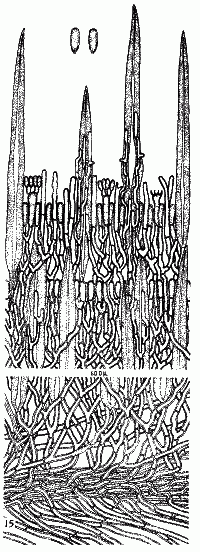|
 Hymenochaete vaginata Hymenochaete vaginata
BiostatusPresent in region - Indigenous. Endemic
Images (click to enlarge)
Caption: FIG. 15. Hymenochaete vaginata G.H.Cunn. Transverse section x 500; spores x 1000.
Showing filiform paraphysate hyphae and setae ensheathed in hyphae. |
Article: Cunningham, G.H. (1957). Thelephoraceae of New Zealand. XIV. The genus Hymenochaete. Transactions of the Royal Society of New Zealand 85(1): 1-51.
Description: Hymenophore resupinate, perennial, membranous-brittle, loosely attached, appearing as
irregular orbicular or linear areas 1.5-4 cm across. Hymenial surface cinnamon, drying date-brown,
irregularly tuberculate, velutinate, not creviced; margin thinning out, fulvous, often
upturned or twisted inwards, coarsely lobed and delicately fibrillose, free. Context
ferruginous, 0.5-1 mm thick, almost wholly composed of setal layers with intertwined hyphae
between, zoned with more deeply coloured reddish-brown bands, near the base composed of
mainly upright intertwined hyphae, cortex reddish-brown, cemented and interwoven, bearing
a dense mat of long abhymenial hairs; hyphal system monomitic; generative hyphae 3-3.5 µ
diameter, walls 0.5-1 µ thick, golden brown, branched, sometimes bifid at the apices, sparsely
septate. Setal layers 5-9, each to 150 µ deep, with rather scattered overlapping setae and
narrow bands of context hyphae between; setae projecting to 110 µ, narrowly fusiform with
long acuminate apices, 90-160 x 9-14 µ, partly or wholly enmeshed in hyphal sheaths, walls
reddish-brown, lumina narrow. Hymenial layer to 30 µ deep, a scanty palisade of basidia,
paraphyses and paraphysate hyphae. Basidia cylindrical or subclavate, 16-20 x 4-5 µ, 4-spored;
sterigmata arcuate, rather stout, to 4 µ long. Paraphyses cylindrical, shorter and
slightly narrower than the basidia. Paraphysate hyphae abundant, filiform, seldom bifid at the
apices, projecting slightly. Spores narrowly elliptical, 7-8 x 2.5 µ, apiculate, walls smooth,
hyaline, 0.1 µ thick.
Habitat: HABITAT: Loosely attached to bark of dead branches and trunks; type of rot not seen.
Distribution: DISTRIBUTION: New Zealand.
Notes: In its stratose structure, monomitic hyphal system, and presence of a cortex the species
resembles smooth forms of H. tasmanica. It differs in the filiform paraphysate hyphae,
different spores, larger basidia, context hyphae of larger diameter, and without dendriform
branches. Setae are much larger and most are enmeshed in hyphal sheaths like cystidia of
Peniophora vermifera. When dry the hymenophore is brittle, and when fractured surfaces
appear vertically fibrillose. Spores are rare, the few seen attached to basidia being of the
dimensions described. Plants are loosely attached to bark, and when dry tend to curl from the
margin either erect or inwards.
|